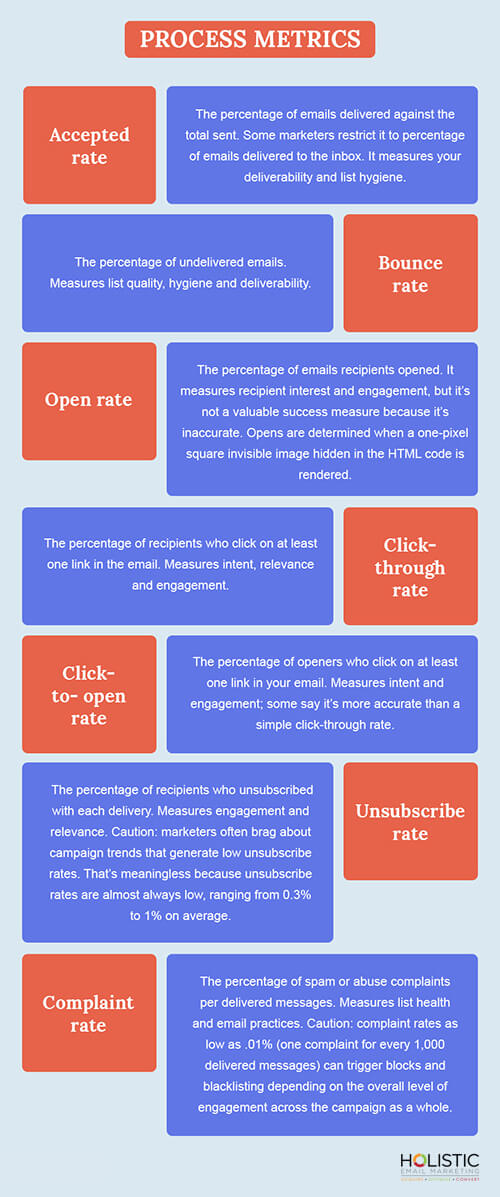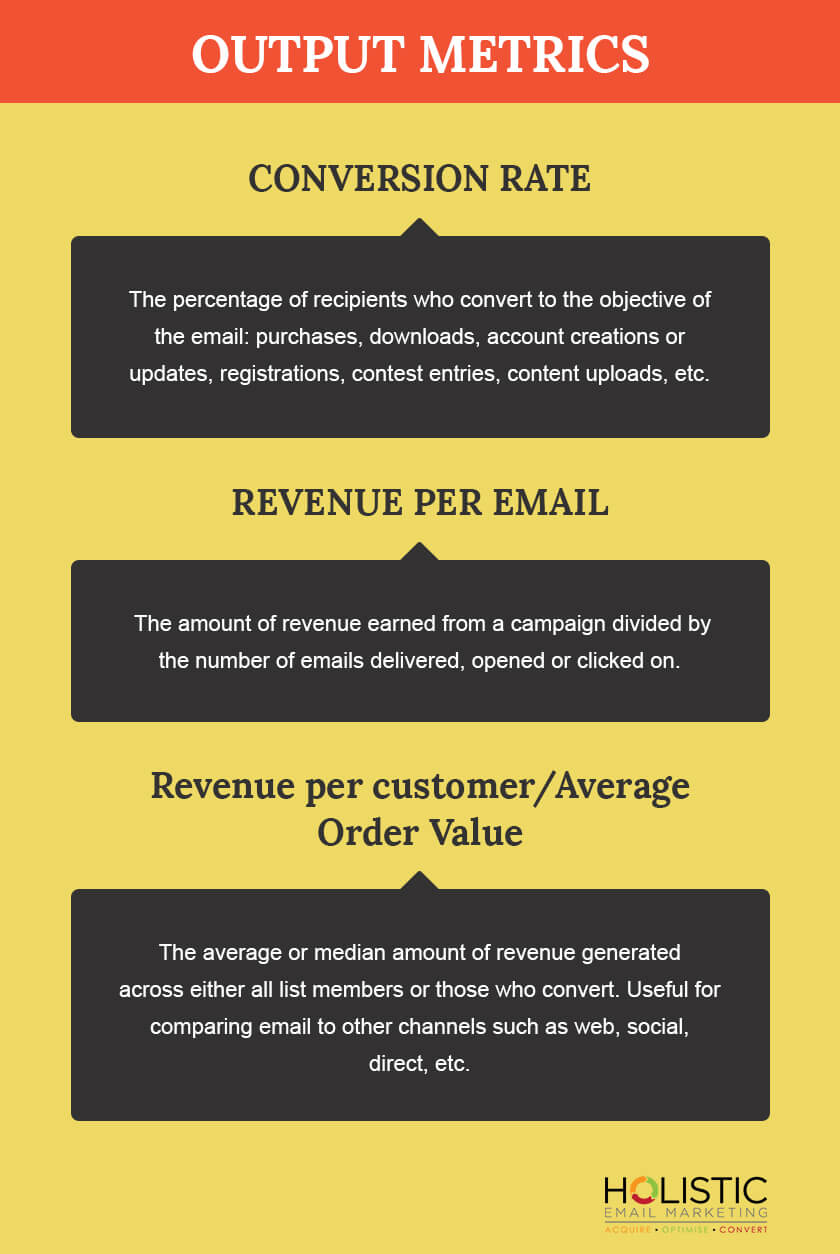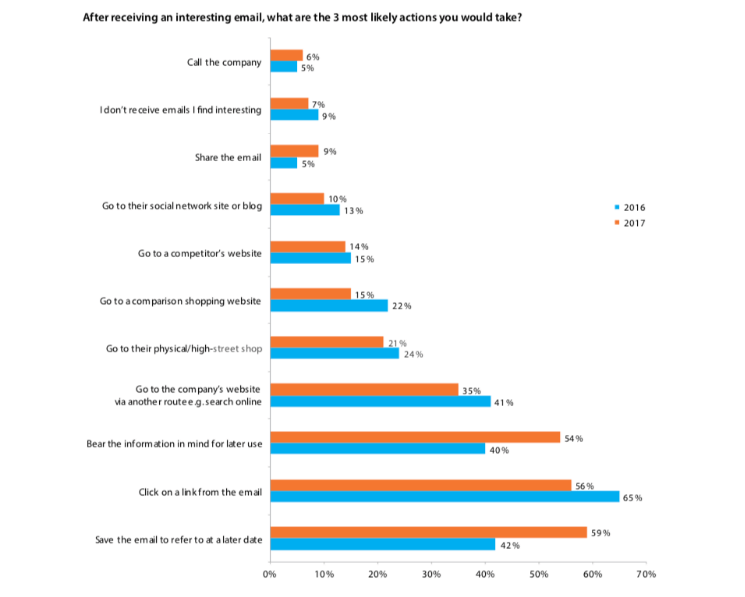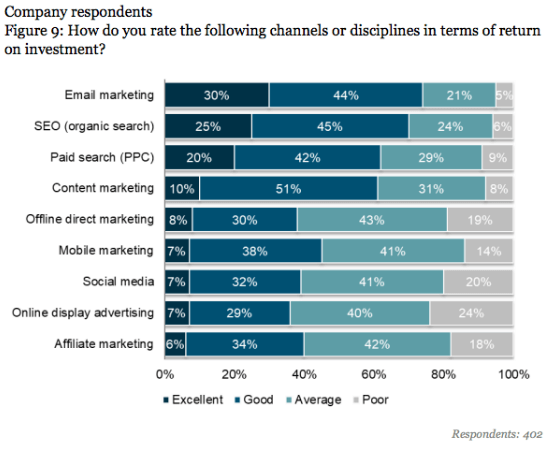Hey Kath, you being an expert in the email marketing industry offering holistic services, I’m sure fellow marketers would love to be enlightened with your insights into Email Metrics Analysis & How to Create Better Campaigns from it.
Well to start with, what are the most important email metrics you can measure from an email campaign?
Kath Pay: It all depends upon what your objective is. For example, if you are a publisher and are paid by advertisers on opens, then opens will be. If you’re a retailer and you want to sell items then AOV, number of items sold, and purchase value will be your key metrics. That isn’t to say that you ignore all the other metrics, such as Opens, Clicks, Click-to-Open Rate, time on site, bounce rate etc. These should all be used in conjunction with your key metrics.
How long should you ideally wait after sending an email campaign before you can begin measuring the metrics?
Kath Pay: Again, it depends (sorry!) – this time on your sales cycle as well as your objective. If you’re B2B or sell high-value items, then reporting on the campaign within one week probably isn’t going to do you any favors. Whilst most companies should start looking at the metrics within a couple of hours, this shouldn’t be when you record them.
Interrogate your full customer data to find the right time to be reporting on these metrics. It will not only help you when it comes to testing, but you may find out, as a brand I know did, that those who open your emails immediately, may be fans and are engaged but not necessarily buyers. They found that those who opened the email on day 2 & 3, were much more likely to purchase than those who opened on day 1.
Other than open rates, click rates and unsubscribes, what other email metrics should an email marketer measure?
Kath Pay: Metrics – especially campaign metrics – generally fall into two general categories: process metrics, which measure activity on your email messages, and output metrics, which measure how well your emails achieved your business objectives, whether at campaign level or company-wide.
Process metrics are the easiest to track but don’t always deliver the greatest insight on how well you achieved your objectives. Marketers often use process metrics to determine success or failure of a campaign, but that’s not what they’re intended to show. Each of these metrics is more meaningful as trend indicators over time rather than a measure of individual campaign success or failure:

Note: There are certain loopholes. For instance, when you are measuring Open Rates, in devices such as the iPhone all images render by default, which may show as an open when the recipient was merely flipping through their inbox. They may have technically opened the email but certainly did not have the time to read it.
Output metrics measure business objectives and are much more reliable when assessing campaign and email programme performance:

Should we be measuring metrics beyond campaigns?
Kath Pay: Email marketers tend to be very campaign-oriented. This is logical, as we send campaigns, so we measure success in terms of campaign metrics.
But, beyond measuring the success of our individual campaigns or even collective campaigns over a period such as a month, there are many other valuable metrics we should be measuring other than campaign metrics. Here are a few of them:
Customer Lifetime Value (CLTV)
In a recent report we wrote on email marketing personalization, we found an incredibly valuable insight. All marketers who measured the success of email personalization using subscriber-metrics such as Customer Lifetime Value along with campaign metrics like clicks and conversions, saw a lift, while only 89% of those who used only campaign metrics saw a lift.
These results confirm that personalization is a customer tactic and as such, we should be using subscriber metrics such Customer Lifetime Value to be measuring the success of it. This also clearly shows that what we measure must map back to our objective. There isn’t just one set of metrics we should all measure.
CLTV also comes to play when we are requested to send that last minute, discount-driven email campaign to ensure the company meets their monthly targets. What long-term price are we paying for these short-term target successes? I’m not saying that we don’t do this, but let’s just be aware that these types of last-minute campaigns can often have a negative effect on our CLTV.
The more we know, the more we can make decisions accordingly. For example, if your company’s goal is to hit their targets on a monthly basis, fully knowing that they’re reducing the CLTV, and you have a robust and successful acquisition programme in place, then that’s fine. If, however, your company’s goal is to drive increased CLTV, and you’ve done your analysis and found that these campaigns do have a negative impact on CLTV, then you now know that you need to find alternative tactics to drive those monthly sales to reach the targets.
Subscriber vs Non-Subscriber Value
This is an incredibly helpful analysis to perform, and as shown in the below analysis that Mailchimp conducted, of 6 billion emails, it can be used to provide evidence of the value of email as a channel and if used as a business case, it can potentially deliver more budget to email.
Mailchimp found:
- Subscribers order at least 25% more frequently than non-subscribers.
- Subscribers spend at least 6% more than non-subscribers.
- Active subscribers are 38% more likely to return for a follow-up purchase than non-subscribers.
- Inactive subscribers are 26% more likely to return than non-subscribers.
One of the reasons why this analysis is so valuable, is that it takes into consideration that email is a branding channel and it ‘nudges’ subscribers to other channels. As shown in the below chart from the UK DMA’s Consumer Email Tracker Report 2017, not all actions taken by the consumer will be attributed to email.
In fact, out of the top 8 actions, only one action taken by the subscriber, will be attributed to email. Some actions will be attributed to other channels (Physical shop, Search, Competitive sites, Social, Blog, website), others will be simply not be tracked and attributed to email because of the time-lapse and the fact that we generally only measure and report on campaigns for one week after the campaign has been sent.

Source: UK DMA’s Consumer Email Tracker Report 2017
Open and Click Reach
Open reach is defined as the total number of unique opens/total number on the list or segment, while click reach is the total number of unique clicks/total number of subscribers in the list or segment.
The metric is measured against a set period (e.g. a quarter) and will vary depending on the nature of your business. FMCG companies may look at this over a quarter while insurance companies may stretch this out to a year or 18 months.
To measure reach you would simply measure how many unique subscribers open (open reach) or click (click reach) at least one email per quarter. By using this metric, you are able to identify the total reach of your campaigns for that set period.
For these engagement metrics to be truly useful, they must correlate to conversions and revenue, such that increasing open reach also increases revenue.
As an email marketer, which out of the two email situations are considered a better email performance?
- An email campaign with low open rates but significant conversions?
- An email campaign with significant open rate but low conversions?
Kath Pay: “A” every day and always. Your conversion (whether it’s sales, registrations, downloads, video views etc.) is the reason WHY you’re sending the campaign in the first place. The conversion metric has to be your primary metric of success for this reason. When performing email audits of company’s past performances, I’ve seen numerous tests that deliver the above results and more often than not, the marketer has gone with the version that delivered the highest opens.
It’s crazy and illogical, and it means that you’re optimizing for the wrong metric, learning the wrong things and leaving money on the table.
Email is a complex business. Where marketers often go wrong is when they claim success or failure by using the wrong set of metrics. By ‘wrong’ we mean taking metrics that are designed for one purpose and giving them meaning and significance they don’t deserve.
Till when do you foresee email marketing continue being the best marketing channel?
Kath Pay: Email is the pillar of digital marketing. Nonetheless, it is one of the most bankable push channel that allows us to send out messages to our email list, encouraging them to visit the website throughout the customer journey and lifecycle stages. Here, the difference is that we don’t need to wait for them to come to us as in social, websites, and search; instead, we drive them there.
An Econsultancy survey shows that for the past 10 years, email has been delivering the highest or second highest ROI. Even so, for the past 3 years in a row, it has delivered the highest ROI. So, in short, email is only getting stronger and more valued as a marketing channel.

What are the takeaways from email metrics analysis that marketers can note to improve their email campaign strategy.
Kath Pay: Measuring metrics and analysis tends to be done half-heartedly by email marketers. That’s not to say that they don’t want to measure, analyze and learn, but often, they’re simply just not given the opportunity to do so, as their schedule forces them to move onto the next campaign.
It’s a Catch-22 situation. If the email marketer were to be given time to measure, analyze and learn, then the company would benefit greatly from it. However, as it’s not built into the campaigns (other than simple campaign metrics such as opens and clicks etc.), it doesn’t get done and the situation doesn’t improve – they’re caught in a cycle. Essentially, companies who don’t measure, analyze and learn beyond these top-level metrics, are leaving money on the table.
- Opens and clicks are good benchmarking metrics and potential indicators of success. But I’ve seen too many wrong decisions being made on the basis of these top-level metrics, and money lost accordingly.
- As with any marketing, there is a funnel to the conversion and ideally every step of the funnel should be measured – all the way throughout the customer journey. Don’t stop at the email metrics. Look to see if there are patterns, or anomalies that could help you to gain insights or form a hypothesis to test.
- Look to see if those campaigns with the highest opens result in the highest conversions. Look to see if those with lower opens, but higher clicks result in the highest conversions. Identify what the differentiator/s between these campaigns were. Also look to see if there are campaigns with high clicks but low conversion, as this could be an indicator that you have a problem with your landing page.
- Finally, move beyond just measuring campaign success and start to measure the valuable subscriber metrics in order to bring greater success to your email program.
Thank you Kath for your precious time and insights.
About Kath Pay:
Founder and CEO at Holistic Email Marketing, Kath Pay lives and breathes email marketing and is recognized as being one of the UK’s leading Email Marketers . She devotes her time to developing customer-centric ecommerce journeys using a holistic, customer-centric approach. An industry veteran who has helped influence email marketing into being the high ROI channel it is today, Kath is a regular expert author, international speaker and trainer. You can connect with her on Twitter.








Kevin George
Latest posts by Kevin George (see all)
Mailable Microsite VI: How Uplers ‘played’ a new tone for Microsoft using Accordion in Emails
Landing Page Designs & Trends You Must Refer